Boeing 720B
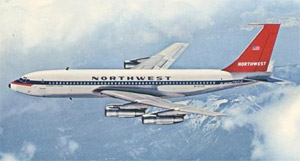
Northwest Airlines Flight 705, N724US
Miami, Florida
February 12, 1963
Northwest Airlines Flight 705 was a regularly scheduled passenger flight from Miami to Portland, Oregon, with intermediate stops at Chicago, Illinois and Spokane and Seattle, Washington. The flight departed Miami International Airport into areas of anticipated turbulence associated with thunderstorm activity. The departure strategy required maneuvering away from the identified thunderstorms immediately after takeoff, in order to climb above the thunderstorms and subsequently fly over them. During the planned maneuvering, approximately 13 minutes after takeoff, and while climbing through 17,500 feet, the flight encountered a strong updraft, resulting in a high nose up pitch attitude and vertical speed of approximately 9,000 feet per minute, and an associated decrease in airspeed from 270 knots to 215 knots. Investigators believed that the pilot responded by applying full nose down elevator and full nose down stabilizer trim to prevent further airspeed loss. Following these control inputs, the airplane entered a steep dive, and accelerated to beyond 470 knots. In spite of recovery attempts by the pilot, the airplane was not able to be recovered from the dive and broke up in flight below 10,000 feet.
The Civil Aeronautics Board determined that the probable cause of the accident was the unfavorable interaction of severe turbulence and large longitudinal control displacements resulting in a longitudinal upset from which a successful recovery was not made.
As the investigation of Northwest Flight 705 proceeded, other jet transports became involved in similar upsets. These pitch upset events were collectively referred to as "Jet Upsets." This terminology was used because the phenomena appeared to be unique to the new generation of swept wing jet transports which began to enter service a few years earlier. The investigation of Northwest Flight 705, and associated similar pitch upset incidents, led to changes in operating procedures and design requirements for jet transports, as well as improved forecasting and dissemination of hazardous weather information to Air Traffic Control and Flight Crews. These actions proved effective in substantially reducing the occurrence of this type of pitch upset events.
History of Flight
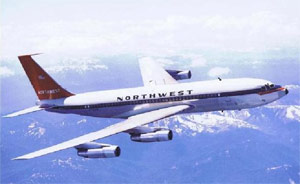
Northwest Airlines Flight 705 was a regularly scheduled passenger flight from Miami to Portland, Oregon, with intermediate stops at Chicago, Illinois and Spokane and Seattle, Washington. The flight departed Miami at 1335 eastern standard time (EST), using a circuitous route during initial climb, in order to avoid areas of anticipated turbulence associated with thunderstorm activity.
Weather in the Miami Area
At the time of the accident, weather in the Miami area was characterized by a pre-frontal squall line approximately 250 miles in length, oriented on a northeast-southwest line immediately northwest of Miami, with tops at 30,000 feet. A weather advisory was called to the attention of the crew by the operations agent at Miami and was attached to their dispatch paperwork. The pilot who had flown the accident airplane inbound from Chicago explained to the captain of Flight 705 that they encountered weather from La Belle, approximately 70 miles northwest of Miami to the Miami VORTAC. The tops were estimated to be 27,000 to 30,000 feet. They had been cleared over the top and then made their letdown to the east of the frontal area.
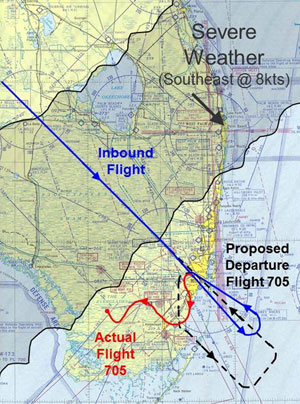
View Larger
Following a review of available weather data, including discussion with the crew handling the aircraft inbound to Miami, a departure was planned to the southeast. By flying southeast, they anticipated climbing away from the squall line, then reversing course after gaining sufficient altitude to overfly the squall, just as the aircraft on the inbound flight had over flown the weather earlier. Following departure from Miami, in accordance with the pilot's request for a southeast vector, a left turn was made after takeoff from runway 27L. Due to conflicting traffic, to the south and southeast the Controller vectored Flight 705 in a southwesterly direction. The limited weather data available to the controller in conjunction with other traffic successfully departing in this direction, allowed for vectoring the flight in the same general direction.
Route Planning
Prior to departing the ramp, at 1325, the flight crew asked the ground controller for information about the active departure routes, and he replied that most flights were departing ". . . either through a southwest climb or a southeast climb and then back over the top of it . . ." At 1335, the flight departed Miami in accordance with the pilot's request for a ". . . southeast vector . . ." A left turn was made after takeoff, and the airplane was vectored to avoid areas of anticipated turbulence associated with thunderstorm activity to the northwest. Subsequently, while maintaining 5,000 feet and a heading of 300 degrees, the flight requested clearance to climb to a higher altitude and was cleared to climb to 25,000 feet at 1343.
Airplane Upset
As the climb to 25,000 feet was initiated, the airplane encountered heavier turbulence for approximately three minutes. The accident report stated, "the indicated airspeed fluctuated from 320 knots to 210 knots." During the climb, turbulence was heavy between 5,000 feet and 15,000 feet, briefly reducing as the airplane climbed through 15,000 feet. Between 15,000 feet and approximately 17,500 feet, the rate of climb was reduced, and the air was relatively smooth, until reaching 17,500 feet, where heavy turbulence began again. Shortly after climbing out of 17,500 feet, the rate of climb increased to approximately 9,000 feet per minute. According to the accident report, this rate of climb was 3 ½ times the previous climb rate. The investigators believed that at this point, the aircraft had entered a severe vertical column of air that resulted in the high rate of climb.
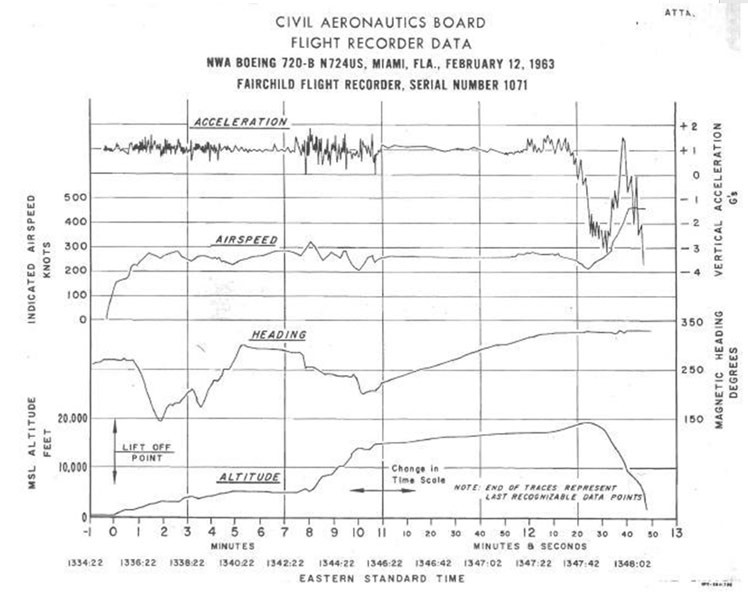
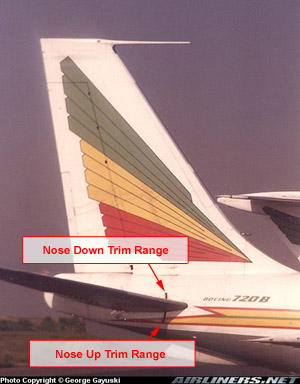
Photo copyright George Gayuski - used with permission
As the airplane penetrated the vertical air column, the pilot, in response to the uncommanded high climb rate, rapidly decreasing airspeed from 270 to 215 knots, perceived an impending stall, and applied full nose down elevator, and almost simultaneous full nose down stabilizer trim. Investigators concluded that the pilot commanded full nose down pitch by an analysis of the flight data recorder, and results of a performance analysis performed by Boeing. The analyses confirmed to the investigators that the flight path required the application of full nose down elevator and the simultaneous use of full nose down stabilizer trim. In response to these control inputs, the airplane rapidly pitched over, having reached a peak altitude of 19,285 feet, and generating vertical acceleration levels of approximately -2G. During the initial stages of the pitch down maneuver, the investigators believed that no subsequent control inputs were made for an eight second period. This was believed to have been the result of the high, and rapidly achieved, negative G forces causing the pilot to lose contact with the controls for approximately 8 seconds. Before the pilot was able to regain contact with the controls, the airplane had achieved a vertical acceleration of -2.8G. As the airplane pitched down into an essentially vertical dive, the airspeed increased, and rate of descent increased rapidly.
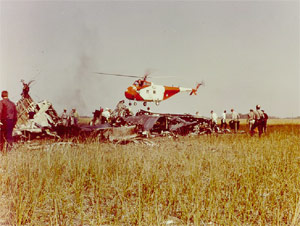
Investigators believed there was a brief period where, in an attempt to correct the dive, the pilot applied nose up elevator, and the vertical acceleration increased to +1.5G, but very rapidly reversed to a value of approximately -3G. It was also believed that the pilot attempted to move the stabilizer trim in the nose up direction to facilitate dive recovery. The stabilizer trim system was overcome by aerodynamic forces and was not able to move. In the last 9 seconds before the flight data recording ended, airspeed increased to 470 knots, at which point the flight data recorder stylus hit its mechanical stop. Investigators believed that the airspeed increase continued until the airplane broke apart in flight at some point below 10,000 feet.
From the onset of the upset to the end of the recorded flight data was 45 seconds. The crash occurred 12 minutes and 48 seconds after takeoff from Miami. All 43 passengers and crew were killed. An animation of the airplane flight path is available below:
Wreckage Reconstruction
Following the inflight breakup, airplane components impacted in a section of the Everglades 37 miles southwest of Miami International Airport. The wreckage was distributed over an area approximately 15 miles long, and 1 1/3 miles wide. Approximately 90 percent of the wreckage, including the largest segments, was concentrated in a two-mile area at the western end of the impact area. A reconstruction of the aircraft was completed in a hangar at Opa Locka Airport on April 1, 1963. According to the accident report:
"The main failures in both wings and horizontal stabilizers were in a downward direction, and virtually symmetrical. The forward fuselage broke upward and the vertical stabilizer failed to the left. All four engines generally separated upward and outboard. The stabilizer trim jackscrew was found positioned within 3/32 inch of the aircraft nose down mechanical stop."
As described, the horizontal stabilizer trim jackscrew was at its nose down limit when operated electrically. Further, the flight control system was examined, and there was no evidence of failure except that associated with in flight break up or ground impact. Examination of the aircraft instruments revealed that the nosedown rotational pitch stops of both vertical gyros, which furnish pitch and roll displacement information for the HZ-4 (artificial horizon) and other devices, received severe impact damage as a result of a rapid rotation of the aircraft about its pitch axis.
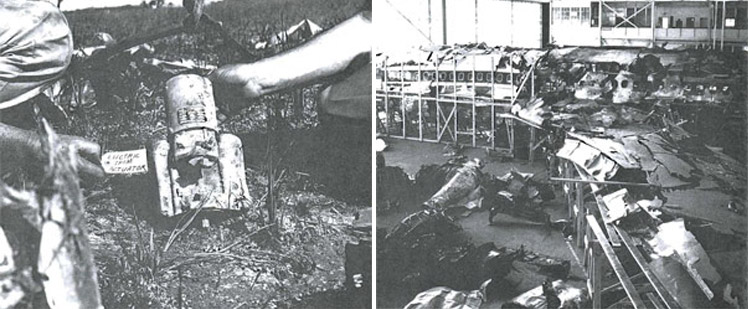
Right, photo of Accident Aircraft reconstruction from CAB Accident Docket file
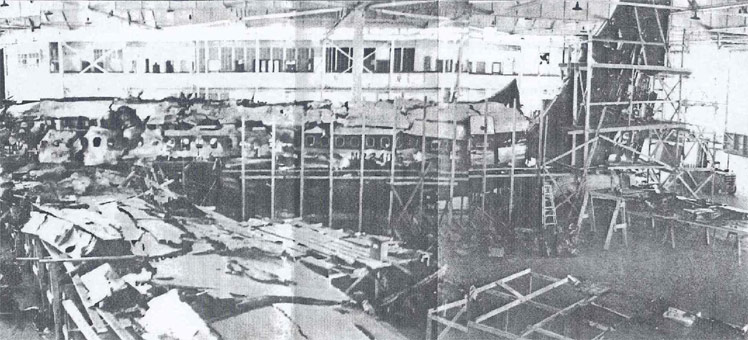

Focus of the Investigation
As the investigation of Northwest Flight 705 continued, a series of similar incidents and accidents occurred within a year on other jet transports. All of these involved a pitch upset from which the aircraft did not recover or was brought under control following extreme loss of altitude. These incidents and accidents initiated at a range of altitudes, from high, cruise altitudes, to relatively low altitudes. Turbulence was a contributing factor in each event, however the turbulence levels encountered were not uncommon, and were handled successfully by this category of aircraft on a fairly regular basis. Although each incident and accident investigation continued to its conclusion, the commonality of pitch upsets led to a mutual exchange of information and actions intended to minimize further pitch upsets.
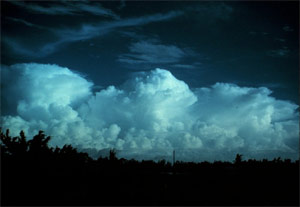
Six months following the Northwest Flight 705 accident, a United Boeing 720 experienced a pitch upset upon encountering severe turbulence while climbing through 37,500 feet near O' Neill Nebraska. Upon comparing the flight data recorder for this incident with Northwest Flight 705, the dive portions were similar. Since the United 720 was able to recover back to normal flight without any structural damage, the incident provided additional information to the investigation effort on Northwest Flight 705.
Civil Aeronautics Board reports noted that, "turbulence of varying degrees, small and large, was involved in each case. The aircraft pitch attitude, airspeed, and altitude varied greatly in positive-negative or increasing-decreasing directions. The crews indicated that large longitudinal control displacements of both stabilizer and elevator were used and required to maintain control. In some of these cases substantial altitude losses were experienced."
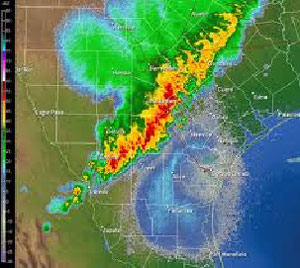
Investigators eventually concluded that, as a class of aircraft, swept wing jet transports appeared to be more susceptible to pitch upset than their predecessor straight wing, propeller transports, and that more research into the phenomenon was needed.
In the accident report for Flight 705, the Civil Aeronautics Board identified three basic areas of concern for the investigation:
- The effect that weather may have had on the flight;
- The pilot's response to the upset;
- The aircraft and its characteristics throughout the upset maneuver.
Weather Associated with Thunderstorms
Thunderstorms are the result of the convective rising of moist air into the atmosphere. Solar heating of the earth warms air directly above it, causing this relatively warm air to rise. This rising can be assisted by hills or mountains, or the combining of warm/cold or wet/dry air masses. As long as the air remains warmer, and weighs less than the air around it, it will continue to rise, in a process known as convection. As the air rises, it transfers heat from the earth's surface to the upper atmosphere. Contained water vapor cools and condenses to form clouds.
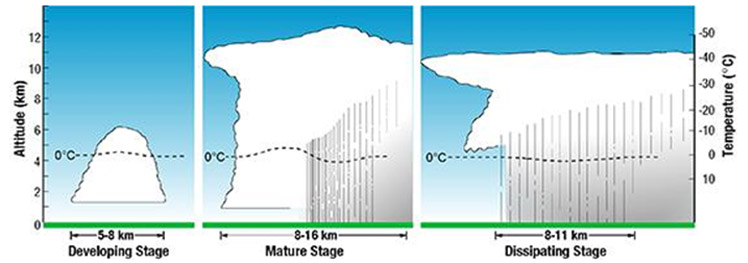
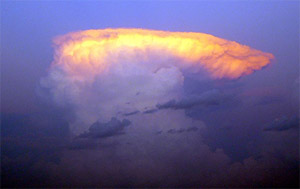
Thunderstorms evolve through three phases. They develop, mature, and dissipate. The developing stage is characterized by cumulus clouds being pushed upwards by a rising column of air. Developing thunderstorms generally contain very little, if any, rain, but may produce lightning. As a thunderstorm matures, updrafts continue to feed the storm, but precipitation begins to fall out of the storm, leading to downdrafts, rapidly descending vertical columns of air. The mature stage produces the majority of rain or hail, high winds, lightning, and tornados. An anvil will form when the rising air reaches the point in the atmosphere where its temperature is about the same as the surrounding air. Cloud growth ceases and begins to flatten out to form the characteristic anvil shape.
Eventually, a large amount of precipitation is produced, resulting in the updrafts being overcome by the downdrafts. This leads to a dissipation of the storm. Rainfall decreases, but lightning may still remain a threat.
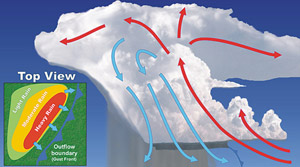
The investigators believed that Northwest Flight 705, by attempting to avoid the worst build ups encountered the strong updrafts that were most likely associated with either the developing, or the mature stage of the thunderstorm they were trying to avoid. The encounter with the strong updrafts caused the airplane to experience an extremely high rate of climb, and rapid airspeed decay, leading to the pilot's aggressive control inputs, and the pitch upset.
This accident and a related series of other almost identical events led to a number of studies into the phenomena associated with thunderstorms and the turbulence that can be encountered in close proximity. Among the outcomes of these studies was the conclusion that high intensity updrafts are expected in the developing and mature phases of thunderstorms, and encounters with these updrafts can lead to flight path upsets.
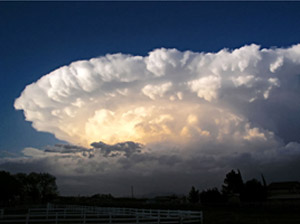
Pilot Response to the Upset
The investigators concluded that Flight 705 encountered an updraft associated with a nearby thunderstorm. As the encounter progressed, the airplane pitched up, airspeed began to rapidly decay, and vertical speed increased to more than triple the value just before the encounter. Investigators believed that the pilot, perceiving an impending airplane stall, applied full nose down elevator, followed almost concurrently with stabilizer nose-down trim, until reaching the electrical trim stop. As a result of the pilot's control inputs, the airplane pitched over into a near vertical dive and attained high negative Gs.
At the time of this accident, it was a wide-spread practice among pilots of the Boeing 707 model family to routinely use horizontal stabilizer trim as a means to reduce the high control forces associated with pitch maneuvers. It was believed by the investigators that the essentially simultaneous application of both full elevator and nose down trim placed the airplane in a situation that rapidly became unrecoverable. The pilot was believed to have been attempting to preserve airspeed and altitude in response to the extremely high vertical speed in the updraft and made the aggressive control inputs to avoid a further degradation of the flight path. The airplane rapidly achieved a vertical, high negative G dive, and upon application of controls in an attempt to recover, the horizontal stabilizer trim motor stalled, and in its full nose down trim position, overcame the elevator capability, preventing dive recovery.
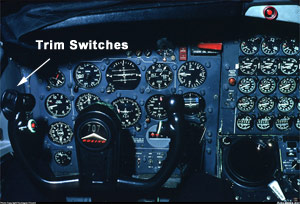
Photo copyright Daubagna Vincent - used with permission
Airplane Response During the Pitch Upset
Flight Control System
The flight control system of the Boeing 707/720 is conventional for the era. The elevators are deflected by control tabs in response to movement of the control column. This displacement of the control tabs, with aerodynamic assistance from elevator balance panels, moves the elevators to cause a change in air load on the horizontal tail surfaces.
The tabs serve two purposes. During low-speed flight, the tabs are used to prevent floating of the elevators as stabilizer trim is changed. When the stabilizer moves, a mechanical linkage deflects the tabs to create aerodynamic forces which keep the elevators faired with the stabilizer. During high-speed flight, movement of the elevators deflects the tabs. The resulting increase in aerodynamic force is reflected as an increase in the force required at the control column to move the elevators. This provides a force gradient that precludes excessive elevator deflection. Moving the flight deck control column aft causes the airplane to pitch up, while moving the column forward results in a pitch down.
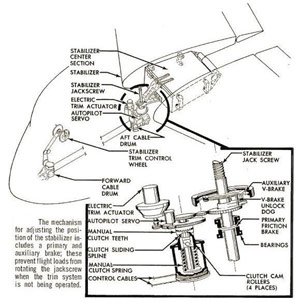
View Larger
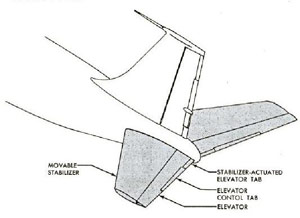
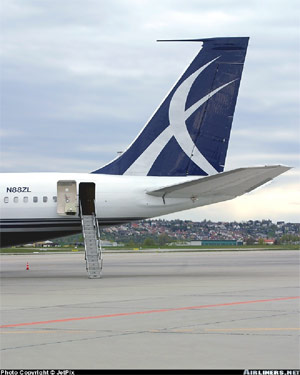
Photo copyright Torsten Maiwald - used with permission
The horizontal stabilizer is an inverted airfoil providing a counteracting force to wing lift and pitching moments, and aircraft weight, balancing the forces to maintain a desired pitch attitude or speed. The horizontal stabilizer is composed of two main components, the trimmable stabilizer, and elevator. The stabilizer is moved by an electrical switch on the pilot's control wheel, or alternatively, by a large wheel located on either side of the flight deck center console. The stabilizer position (trim setting) is also indicated on either side of the center console. When trimming the airplane, the horizontal stabilizer is moved by an electric motor, attached to a jack screw.
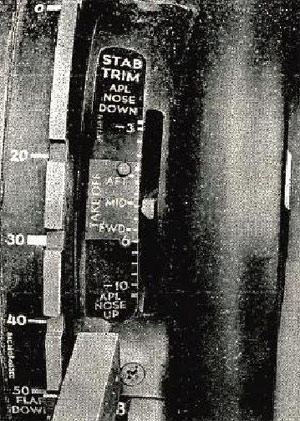
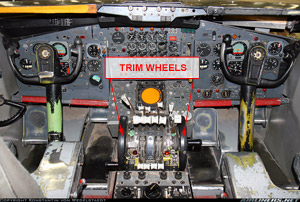
Photo copyright Konstantin Von Wedelstaedt – used with permission
View Larger
The horizontal stabilizer assembly contains a clutch mechanism that is intended to slip when horizontal stabilizer loads become too high, or in the case of a jam elsewhere in the trim system. In the case of a jam, the clutch is designed to slip in order to preclude structural damage in the stabilizer, which is primary airplane structure. In the accident sequence, the pilot attempted to use airplane nose up trim in addition to elevator. Investigators believed that high airloads caused the clutch to slip, resulting in the failure of the stabilizer to move. This "stalled" condition, with the stabilizer remaining in the full airplane nose down position, effectively overcame the elevator, and prevented recovery from the dive.
The terms center of lift and center of gravity are commonly used to reference locations where lift and weight are acting. The center of gravity will move forward or aft over a small range as persons move around the cabin, and as fuel is used. The center of lift can move forward or aft due to changes in lift resulting from speed or weight changes (fuel burn). Additionally, the center of lift moves aft as Mach number increases. On swept wing aircraft, due to the wing sweep, the center of lift and center of gravity have a greater range of movement. This in turn requires a larger balancing force from the horizontal stabilizer.
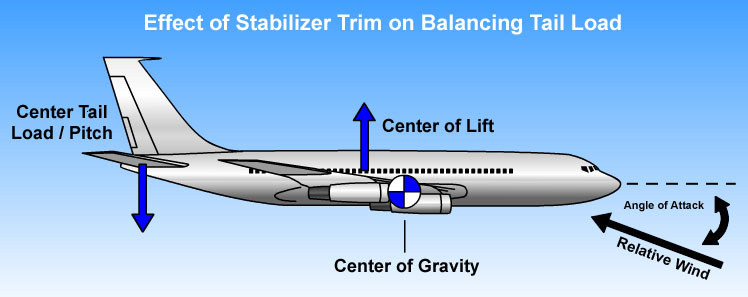
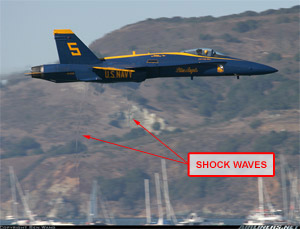
Photo copyright Ben Wang – used with permission
View Larger
Speed of Sound and the Formation of Shock Waves
The speed of sound at the surface of the earth is a measure of the speed that a vibration travels through the atmosphere. At sea level on a standard day, this speed is approximately 760 miles per hour (661 knots) and decreases with increasing altitude due to a decrease in temperature of the air. For example, at 36,000 feet, the speed of sound is approximately 660 miles per hour (574 knots). A method of comparing the speed of an airplane (or any object travelling in the atmosphere) to the speed of sound is a ratio of the speed of the plane divided by the speed of sound at that point in the atmosphere, and is referred to as the "Mach Number", named after the Austrian physicist Ernest Mach. An airplane travelling at exactly the speed of sound would be travelling at "Mach 1.0", while an airplane travelling at half the speed of sound would be travelling at Mach .5. The region of speed below Mach 1.0 is the sub sonic region, but more specifically the region from approximately Mach 0.70 to slightly beyond Mach 1.0 is referred to as the transonic region. Flight at speeds beyond Mach 1 is referred to as supersonic. The quest for higher flight speeds by civil air transports resulted in the adoption of swept wing designs. Swept wing designs delay the onset of shock waves at high subsonic speeds, and permit cruising at 80 to 85% of the speed of sound
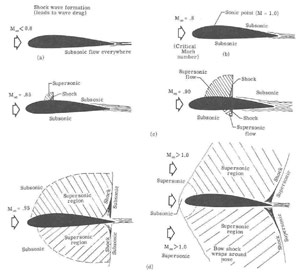
View Larger
At speeds below the transonic region, air flows smoothly around the airplane. In the transonic region, airflow begins to reach the speed of sound in localized areas on the aircraft, including the upper surface of the wing. The Airplane Mach number at which airflow over the wing first reaches Mach 1 is known as the critical Mach number.
Air flows more rapidly over the upper surface of the wing, resulting in a lower pressure than on the lower surface. This pressure differential between the two surfaces is what creates lift. At jet transport cruising speeds (typically Mach 0.80 - 0.85), the airflow over the upper surface of the wing becomes supersonic. As the local airflow over the wing becomes increasingly supersonic, shock waves form and increase in strength and extent. Shock waves are formed by a large pressure gradient that results from the formation of supersonic flow regions on the wing. As air moves through the shock wave, it suddenly decelerates to become subsonic. The shock wave is the location where this transition occurs. Downstream of the shock, i.e., in the subsonic region, airflow may also be separated, resulting in an incremental decrease in lift, and/or if there are control surfaces downstream, a reduction in their effectiveness. Additionally, the separated airflow will induce buffeting that will increase as the separation becomes more extensive. This is known as Mach buffet and is a component in the establishment of an airplane buffet boundary which is avoided in normal operational conditions.
An additional effect on the elevator results when shock waves form on the horizontal stabilizer. As the shock waves strengthen with increasing Mach, turbulence is produced downstream. This turbulence can reduce the effectiveness of the elevator and result in reduced control authority when flying in transonic speed ranges.
In this accident, as the flight data recorder airspeed measurement reached its limit of travel at an indicated airspeed of 470 knots, the highest speed attained could not be determined. Extrapolation of the airspeed trace to the end of the recording period would imply that the airplane may have reached speeds as high as 550 knots. If this speed is considered as an upper bound, at 10,000 feet, the flight Mach number could have been as high as .95. This would have been well into the transonic region, and shock waves on the wing and horizontal stabilizer would have been well developed.
Shock waves develop on the stabilizer near cruise Mach numbers. The resulting disturbance to the air behind the shock waves causes the elevator to lose some of its effectiveness.
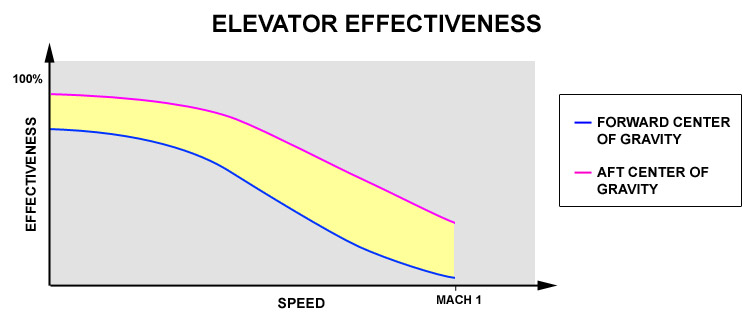
About the time of this accident, the Shell Oil Company produced a film on transonic and supersonic aerodynamic effects. The film can be viewed below:
Airplane Stall
At low speed, airplanes experience aerodynamic stall when the airflow over the wing is no longer sufficient to support the airplane weight. At elevated Gs, stall speed will increase. As a stall develops, the normally smooth airflow over the upper surface begins to separate. This airflow separation is perceived as a shaking of the airframe than can become intense. As a stall progresses, a greater portion of the wing experiences unsteady airflow. At a point, the loss of lift is such that lift is now insufficient to support the airplane. On a swept wing airplane, the center of lift will typically shift outboard as the lift loss develops, which results in a nose down pitch, aiding in recovery from the stalled condition. The recovery is completed by the use of elevator to reduce the airplane angle of attack.
In this accident, the investigators concluded that due to the rapid increase in vertical speed, decrease in indicated airspeed, and possible high pitch attitude, the pilot became concerned that if these flight conditions continued, the airplane would stall. In attempting to prevent the stall and recover from the adverse flight conditions he was experiencing, he applied full nose down elevator and full airplane nose down trim, resulting in the pitch upset.

View Larger
Buffet Boundary
Beyond thresholds defined either by Mach number for high speed, and aerodynamic stall, the buffet associated with each phenomenon defines an airplane buffet boundary. As Mach number increases, Mach buffet becomes the limiting factor in determining maximum lift available. At low speed, stall buffet is the limiting factor. As operational altitudes increase, the speed at which low speed (stall) buffet occurs is increased. At high altitude, both stall buffet and Mach buffet can occur at the same indicated airspeed. During airplane development, operational speeds are determined that will provide margin from the buffet envelope, and normally avoid operation in speed regions where buffet will be encountered. In this accident, neither buffet phenomenon was originally a factor. However, as the dive progressed, the airplane may have reached a sufficiently high Mach number for buffet to have been experienced.
Control Forces
Pitch control forces on the B707/720, though they complied with the regulatory requirements, were generally high, and fleet pilots had developed a technique to use horizontal stabilizer trim, in concert with pitch control inputs, as a means to mitigate the high forces. Regulatory requirements at the time did not specifically address upset or out of trim conditions, and there were no requirements for control forces to remain positive at speeds beyond VNE (VMO/MMO). The only force limitation at the time of airplane certification was that pitch control forces during cruise could not exceed 50 pounds. During the early stages of the upset, investigators stated their belief that both pilots lost contact with the control for an 8 second period, after the elevator had reached its full airplane nose down position, and horizontal stabilizer trim had reached its full airplane nose down position. Though the investigation could not conclusively demonstrate that a control force reversal resulted while in the mistrim condition discovered in wreckage examination and in the speed, range associated the upset, investigators speculated that the controls did, in fact, reverse, and were a significant factor in the development of the unrecoverable dive.
Mach Tuck
Also, as speed increases into the transonic region, the center of pressure on the wing moves aft toward the trailing edge. A swept wing results in increased forward to aft travel of the center of lift. This effect becomes noticeable as a progressive nose down pitching tendency. This nose down pitching tendency is referred to as Mach Tuck.
Jet transports employ systems that automatically compensate for this nose down tendency. As the nose down pitch tendency increases, the airplane is automatically retrimmed (usually by moving the horizontal stabilizer) to maintain the desired cruise conditions.

From Boeing Airliner July 1959
In this accident, Mach tuck did not have a direct influence that was noted by the investigators, however, as the descent airspeed increased beyond the 470 limit of the data recorder's capability, it may have had a secondary effect on the recovery capability. One of the results of research that was conducted subsequent to this accident, and following the other related similar events, where the event airplane was already at high altitude cruise, and correspondingly high Mach numbers, Mach tuck may have played a role in the developing upset. An animation detailing key factors in this accident can be viewed below:
Flight Instruments
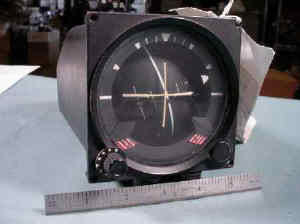
In the final forty seconds of Northwest Flight 705, the aircraft entered a pitching maneuver that produced high negative g loading. The situation encountered was beyond what an airline pilot would normally experience and would be startling. The investigators concluded that the high negative g loading most likely caused the pilot's hands and feet to be forced upwards, off of the controls, while loose articles were slammed against the overhead. After an 8 second delay, the accident report stated that the pilot was able to regain contact with the controls and attempt to regain control of the airplane.
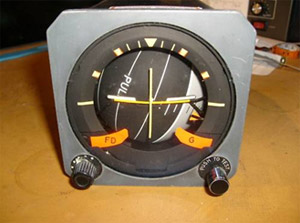
The attitude indicators in early jet transports, such as the one in the Boeing 707/720 instrument panel, did not provide adequate pitch information in extreme nose up or down pitch attitudes. The background was entirely black and there were no pitch markings beyond the +/- 20 to 30 degree normal range. When an airplane got into an extreme pitch attitude the display did not indicate if the aircraft was pointed up or down, or at what angle relative to the horizon. As a result, revised attitude indicators with a light background above the horizon (sky), and dark background below the horizon (ground), along with additional pitch markings were developed and retrofitted to most fleets.
In summary, an appropriate understanding of aspects associated with jet upsets became a part of airline flight crew training programs following the Northwest Flight 705 and United Airlines O'Neill, Nebraska pitch upsets. An FAA report, titled "Upset," was produced on film in the mid 1960s as a training aid for flight crews. The movie can be viewed below:
Airplane Inflight Breakup
The structural capability of the Boeing 720B, and other jet powered aircraft of that era, was specified in terms of limit and ultimate loads. In general, the limit load is condition which represents the highest load ever expected to occur in the life of a fleet of aircraft. Ultimate load was specified by multiplying the limit load by a safety factor, usually 1.5. During design testing, the airplane, and components, such as the wings, are tested to ultimate load in ground test equipment, to verify the validity of the ultimate load calculations. The strength requirements are met at each combination of airspeed and load factor on and within the boundaries of the representative maneuvering and gust envelopes. The Boeing 720 underwent this type of testing prior to receiving its CAB type certificate and was demonstrated to meet all the structural criteria contained in CAB regulations.
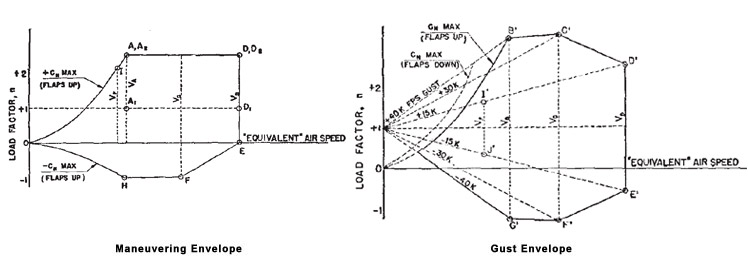
As the dive progressed, the airplane accelerated beyond its intended design speed envelope, and broke apart in flight. Investigators believed that the breakup occurred at some point below 10,000 feet altitude, at a speed in excess of 470 knots, and a load factor of approximately -3.5G. The point of first failure, based on examination of the wreckage, was the horizontal stabilizer. Relative to the design requirements, the airplane achieved speeds, and inflight loads well in excess of the structural envelopes, and well beyond what was ever expected to be encountered in flight.
As an illustration of the inherent strength of jet transports, a video of a Boeing 777 test of the wing ultimate load is available below:
Conclusion
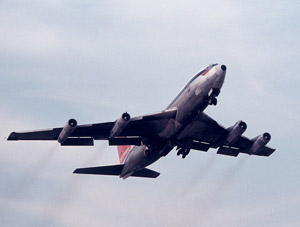
Photo copyright Art Brett, Photovation.net - used with permission
Following the Flight 705 accident, three other events occurred that were very similar in nature, but that did not result in the loss of the airplane. All of these events involved an inflight upset while flying in heavy turbulence, sudden encounters with a vertical column of air, and pilot use of full nose down elevator and full airplane nose down stabilizer trim. All the flight crews had stated, similarly, that recovery from the ensuing dive involved very high control column forces, requiring both pilots to apply recovery controls at the same time. While the other events were severe, the fact that the airplanes had not been lost allowed a great deal of data to be gathered relative to these upsets and shed light on what may have occurred on Flight 705. The crash, and the three similar events, became the catalysts for a large body of research, including testing conducted by the National Aeronautics and Space Administration (NASA) at the NASA-Ames Research Center. The research conducted allowed a significant expansion in knowledge relative to this type of upset event. Subsequent changes in airplane designs and training were successful in mitigating the risk of future occurrences of this type of upset accident.
Acknowledgment
The FAA wishes to acknowledge the contribution of the family of John C. Heil, Jr. in the creation of this accident module. Mr. Heil was a passenger of Flight 705.
The Civil Aeronautics Board (CAB) did not present formal findings within the accident report, however, the investigation identified three basic areas of concern:
- The effect that weather may have had on the flight;
- The pilot’s response to the upset;
- The aircraft and its characteristics throughout the upset maneuver.
To address these concerns, and as part of the investigation, a number of studies were conducted based on flight recorder data. Boeing also conducted a simulator study investigating a number of possible upset scenarios. The various simulations included one flight with no control input from the pilot after the beginning of the updraft encounter, another with pilot control input sufficient to maintain a constant horizontal attitude during the encounter, and others. A comparison of the flights indicated that the induced acceleration forces were lowest if no control inputs were made. "Stick-fixed" (constant attitude) flight resulted in fairly large pitch excursions, but the airplane’s inherent stability allowed successfully transiting the upset.
As stated in the accident report:
"The results of the simulated gust computer studies provided still another indication that gusts and/or drafts alone, even of the type and magnitude believed to have been imposed on flight 705, would not generate a G trace of the type shown on the flight recorder record."
The picture of the final maneuver, then, that emerged from initial consideration of the evidence was that of an intact aircraft describing a path in space as a result of unusual longitudinal control displacements. It was inconceivable to consider the captain imposing such large control displacements unless prompted to do so by the most exceptional circumstances, and it was equally difficult to conceive of any control difficulty that could account for the elevator-stabilizer time history required for the maneuver.
"Two of the three broad conclusions......are in essential agreement with the Board's assessment of the evidence as presented in preceding paragraphs. They also conclude that the wreckage examination disclosed no physical evidence of a failure which caused the accident, and that....analysis of flight recorder data has produced strong evidence that positioning of the elevator and horizontal stabilizer were directly responsible for the final maneuver from which the airplane did not recover."
In the final seconds "the airspeed was at or beyond 470 knots, the altitude was nearing 10,000 feet, and the vertical acceleration was again moving in a negative direction indicating that the excessive airspeed and air loads were precluding a successful recovery at this time. During the dive the pilot undoubtedly attempted to retrim the stabilizer in the aircraft noseup direction, but these attempts were unsuccessful because the high down elevator loads had by that time stalled the stabilizer electric drive motor, preventing system operation by the pilot column trim switches.
There is no doubt that the severe weather was instrumental in producing the upset. Also, there is little doubt that the aircraft characteristics had a significant bearing on the pilot's control displacements and on the final noseover maneuver. Accordingly, the board has concluded that the unfavorable interaction of high vertical air currents and large longitudinal control displacements resulted in the longitudinal upset."
Probable Cause
The CAB issued the following statement of probable cause:
"The Board determines that the probable cause of this accident was the unfavorable interaction of severe vertical air drafts and large longitudinal control displacements resulting in a longitudinal "upset" from which a successful recovery was not made."
The entire accident report is available at the following link: Civil Aeronautics Board Accident Report
The CAB made a number of recommendations, ranging from upset recognition and training, to airplane design considerations. The Boards recommendations, excerpted from the accident report are available at the following link: (Accident Board Recommendations)
Certification regulations
The Boeing 720B was designed to Civil Air Regulations (CAR 4b) dated December 1953, (reference Type Certificate Data Sheet, 4A28).
Regulations relevant to this accident are:
CAR 4b.140 - Trim, General
CAR 4b.142 - Longitudinal Trim
CAR 4b.151 - Static Longitudinal Stability
(CAR 4b.140, .142, and .151) (Note: CAR 4b.142 was revised at amendment 2 to modify the required trim speed range - the amended version is also included here)
CAR 4b.312 - Installation
CAR 4b.603 - Flight and Navigational Instruments
CAR 4b.711 - Never Exceed Speed VNE
(CAR 4b.603 and .711) (Note: CAR 4b.711 was revised at amendment 3 to add a note at the end of the rule - the amendment is also included here)
Operational Regulations
At the time of the accident, Civil Air Regulations Part 40 (now CFR Part 121) specified training requirements for pilots.
Training requirements in effect at the time of the accident required an initial check out. Recovery from unusual attitudes not exceeding 10 degrees in pitch with 45 degrees of bank was a part of the initial check out for Boeing 720B captains. However, following the initial check out, unusual attitudes were not repeated in recurrent training, nor was any flight simulator training required.
Swept Wing Aircraft
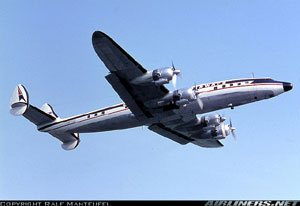
Photo copyright Ralf Manteufel - used with permission
In order to provide higher cruise speeds, jet transport manufacturers had developed, and begun to employ, highly swept wings. Wing sweep delayed formation of drag inducing shock waves and allowed cruise flight at higher speeds and Mach numbers than had been previously attained by earlier vintage aircraft. A negative effect of the ability to fly at higher speeds was that airplanes, once upset, had the ability to rapidly accelerate to much higher flight speeds, or decelerate to lower speeds. The rapid onset of upset conditions was a relatively new phenomenon to jet transport pilots, who at the time of this accident were still, in many cases, transitioning out of propeller driven, non-swept wing, relatively slower aircraft. In this accident, the transition from a stable climb to a vertical dive occurred in approximately 12 seconds, and speed increased to beyond the specified limit flight speeds. While this type of upset would have presented a perhaps unrecoverable situation in an aircraft of earlier vintage as well, the swept wing, high speed configuration of the B720 was a contributor to the rapid development of the upset.
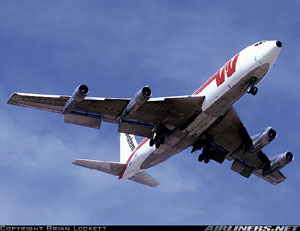
Photo copyright Brian Lockett - used with permission
Trimmable Horizontal Stabilizer
A movable horizontal stabilizer, intended to provide airplane trim, was a relatively new development with the advent of the B707/720 and McDonnell Douglas DC-8. Based on the wide range of flight conditions to which the airplanes were exposed during normal operation, and the need to trim for all these conditions, the horizontal stabilizer was capable of a wide range of motion. While a great benefit to flight crews in relieving forces that could be extremely fatiguing over long flight legs, the available range of motion could also result in severe "out of trim" conditions from which recovery was difficult. In this accident, a severe out of trim condition was created by the pilot's use of trim to augment his nose down elevator inputs, and a large, unrecoverable nose down pitch upset was the result.

Photo copyright (left to right): Gabe Pfeiffer, Mel Lawrrence, Edward Kehler, George Gayuski - used with permission
Use of Stabilizer Trim to Augment Elevator Pitch Forces
Jet transports of the era (B707/720, McDonnell Douglas DC-8) generally had high control forces, due primarily to the control system design. The pitch control system on the 707/720 moved the elevator via tabs, which were controlled by the pilots through the control yoke. As a means to alleviate the high forces, especially associated with takeoff rotation, flight crews developed a technique to use electric trim, in concert with elevator control commands. While not trained by airlines, or recommended by any of the manufacturers, the technique was pervasive, and widely employed by flight crews. The accident report referenced the fact that the horizontal stabilizer of the accident airplane was in the full airplane nose down position. This fact led to the conclusion by the investigators that the crew, having encountered a vertical upset, and faced with what may have appeared to be a high nose up attitude, and an impending airplane stall, applied full nose down elevator, and almost simultaneous airplane nose down trim, eventually reaching the electrical trim stop. This resulted in the nose down pitch upset from which the airplane was not able to be recovered.
The horizontal stabilizer had a range of airplane nose down trim motion available that was in excess of trim requirements.
- The horizontal stabilizer is intended to trim the airplane for a wide range of flight conditions and airplane configurations. However, the available airplane nose down trim was more than was required. As a result, when the pilot used full airplane nose down trim in conjunction with full nose down elevator, the airplane entered a high negative G vertical descent. In attempting to recover using both full up elevator and full airplane nose up trim, the trim motor stalled, preventing motion of the stabilizer, and overpowering the elevator, effectively preventing recovery. Subsequent to the accident, an airworthiness directive was issued which limited the amount of airplane nose down trim available.
Use of trim, concurrent with elevator inputs, as a means to relieve elevator control forces.
A common finding in all of the four pitch upset accidents and incidents involved a horizontal stabilizer trimmed to the full airplane nose down position. Pilots often simultaneously used trim in conjunction with elevator to alleviate control forces. It is appropriate to re-trim when establishing a change in airspeed, configuration, or thrust. However, the concurrent use of trim, effectively using the horizontal stabilizer as a primary control surface, can result in a severe mistrimming of the airplane, and an unrecoverable pitch upset.
Manufacturers assumed that horizontal stabilizer would be used to trim the airplane, and not used as a primary flight control. The use of trim as a pitch control provides a high level of control authority, and it was assumed that except as necessitated by trim requirements, the full airplane nose down authority of the stabilizer would not be used.
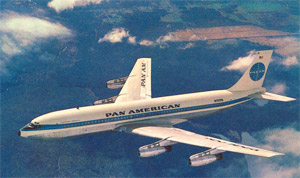
On February 3, 1959, Pan American Flight 115, Boeing 707-121, N712PA experienced a pitch upset resulting in substantial loss of altitude before control was regained. The Boeing 707-121 had just entered service in October 1958. Experience in the operation of jet aircraft was limited when this incident occurred. The aircraft was cruising at Mach 0.82 at 35,000 feet when the autopilot disengaged, and the aircraft slowly and smoothly entered a descending spiral. The pilot was initially unable to effect a recovery, and instrument reference was unreliable due to tumbling of the artificial horizon (night and instrument conditions), and the horizontal stabilizer trim had reached the full nose down position and would not respond to nose up trim commands.. Through a combination of manually trimming the stabilizer and reference to other instruments the descent was arrested at 6,000 feet.
Although this airplane did not experience a violent pitch over there were similarities to later events. The artificial horizon instrument tumbled. The horizontal stabilizer could not be trimmed, believed by investigators to have been the result of high aerodynamic loads and reduced elevator effectiveness in the high transonic speed range. The accident report recommended that company training emphasize the narrow margins between Mach 0.82 and MNE (Mach Never Exceed Speed) and the brief interval of time it takes the aircraft to accelerate into the critical speed range. View the CAB Report.
Design Changes
Following certification of the 707 in late 1958, additional swept wing jet transports entered service and experience with this type of aircraft increased rapidly. This early operational experience indicated that these aircraft could easily exceed the airspeed operating limitations, and undesirable longitudinal pitch stability could occur under extreme conditions. This experience prompted several changes to the existing transport airplane certification regulations. Amendment 12 to Civil Air Regulations (CAR) 4b and Special Regulation 450, became effective May 3, 1962. The preamble to amendment 12 provides a comprehensive explanation of associated changes:
CAR 4b - Amendment 12 Preamble and complete set of regulatory changes
Airplane Stability
CAR 4b.151 Static longitudinal stability
CAR 4b.155 Stability during cruising
These changes introduced the concept of a boosted control system where the control surfaces may not be directly connected to the control device (such as a control yoke) and required that a control surface move in the correct sense, based on the control input, and added the requirement for specific "stick force" gradients of 1 pound per six knots of airspeed change. This rule change also adopted the nomenclature changes required by CAR 4b.191.
With the inception of 14 CFR 25, these rules transitioned into:
14 CFR 25.173 Static longitudinal stability, and 14 CFR 25.175. Demonstration of static longitudinal stability.
Airplane Handling Characteristics
CAR 4b.191 High speed characteristics.
This regulatory change introduced the requirement to evaluate airplane upset characteristics, and requirements for recovery capability following an inflight upset condition. This regulation also utilized new nomenclature as introduced in 4b.711 and SR-450.
With the inception of 14 CFR 25, this rule transitioned into:
14 CFR 25.253 High speed characteristics.
Following this accident, and other similar events, numerous Special Conditions were issued as certification criteria for a number of new designs. These Special Conditions required evaluation of airplane characteristics resulting from a specified degree of mistrim. These Special Conditions were ultimately codified into a new rule:
14 CFR 25.255 Out of trim characteristics.
This rule also specified control force limits for inflight maneuvering (stick force per g), and that control force reversal could not occur prior to reaching VDF/MDF.
Airplane Operating Speeds
CAR 4b.711 Maximum operating limit speed VMO/MMO
This regulation defined the maximum operating speeds VMO/MMO, specified the type of upset maneuver to be evaluated during airplane certification, and in order to establish adequate margins from dive speeds during upset recovery maneuvers, required that not more than 1.5 G be used for recovery.
In addition, Special Regulation (SR) 450 was issued to explain the change to the maximum operating speed reference to VMO/MMO.
(SR-450) Airspeed Operation Limitation for Transport Category Airplanes
With the inception of 14 CFR 25, this rule transitioned into:
14 CFR 25.1505 Maximum operating limit speed
Airplane Instruments
CAR 4b.603 Flight and navigational instruments
This regulatory change required the incorporation of an aural overspeed warning device for any airplane with a VMO/MMO that was greater than .8 VD/MD, or .8VDF/MDF, and the required warning thresholds as a function of airspeed and Mach number.
With the inception of 14 CFR 25, this rule transitioned to:
14 CFR 25.1303 Flight and navigation instruments.
CAR 4b.612 Flight and navigational instruments
This regulation adopted the new terminology VMO/MMO and VFC/MFC as specified in CAR 4b.711
Airplane Flight Manual
CAR 4b.740-1 Preparation of Airplane Flight Manuals for aircraft certificated in the transport category (FAA policies which apply to CAR 4b.740)
- Adopted the new terminology of VMO/MMO
CAR 4b.741 Operating limitations
- Required inclusion of the maximum operating limit speeds in the flight manual, and a corresponding statement that these speeds could not be exceeded during normal operations.
Operational Changes
The Following Advisory Circulars pertinent to operations were issued:
AC 120-5 High Altitude Operations in Areas of Turbulence issued August 26, 1963 - Provided general guidance on appropriate turbulence penetration speeds, attitude control, and autopilot use. AC 90-12 Severe Weather Avoidance, issued April 15, 1964 - Provided general guidance on procedures and limitations of Air Traffic Control for handling air traffic in area of turbulence. AC 120- 13 Jet Transport Aircraft Attitude Instrument Systems issued June 26, 1964 - Provided information on suggested methods to improve the performance and enhance interpretation of attitude indicators. At the time of the accident, attitude indicators displayed pitch markings up to a range of +/- 20 degrees on a black background. To improve situational awareness, a light background above the level pitch line was suggested to provide quick recognition of relative pitch attitude. Additional pitch markings were added to provide relative pitch indications for extreme attitudes.
Flight Instruments

Operational procedures for jet transports in turbulence were reviewed as a result of the Northwest Flight 705 accident and other pitch upsets. Some of the significant operational changes follow:
Turbulence Penetration Speed: Prior procedure established the turbulence penetration speed mid-way between the stalling speed and the speed at which the design limit load would be reached if the design gust was encountered. A higher speed provides adequate structural margin while reducing control problems and provides a greater margin above stall. For simplicity, a constant IAS was adopted below 34,000 feet and a constant Mach number above. This change resulted in an approximate 25-30 knot increase in recommended turbulence penetration speed for most jet transports. Further, stall / buffet boundary diagrams for 1 and 1.5g loads were incorporated in flight manuals (Refer to Northwest Flight Standards Bulletin No 8-63 for examples.)
Attitude Flying: The attitude indicator should be the primary instrument in turbulence as other instruments may provide misleading information on pitch attitude. Altitude control and airspeed control become secondary to attitude control.
Autopilot Operation: The autopilot should be used with the altitude hold function off. Trim should be monitored since the autopilot may re-trim. Use of the autopilot will relieve the crew of basic flying and allow for better overall monitoring.
A summary of the industry efforts was presented in AIAA Paper No. 64-353 "Jet Transport Operation In Turbulence" by Paul A. Soderlind, 1964.
In 1998 a Federal Aviation Administration (FAA)/Industry work group co-chaired by Boeing, Airbus and the Flight Safety Foundation developed the 'Airplane Upset Recovery Training Aid' as training program guidance for upset recovery training for air carrier flight crews. (Upset Recovery Training Aid)
AD 64-10-02, Effective June 5, 1964, required replacement of Horizontal stabilizer trim limit switches on 707/720 series in accordance with Boeing Service Bulletin 1635 (R-1). The limit switches were originally installed to prevent the stabilizer jack screw from striking the mechanical stops. The Service Bulletin relocated the switches to limit the amount of electric trim available AD 65-13-01 Effective July 15, 1965, required several actions including further restrictions in the stabilizer trim settings on certain 707 airplane models. It modified horizontal stabilizer electric trim limits on the 707/720 series. Service Bulletins 1699(R-1) and 1990 revised stabilizer trim limits. Service Bulletin 1990 revised nose down trim to 0.6 degrees on specific 707 airplanes to improve controllability in severe turbulence.
A description of the 707/720 stabilizer trim limit revision is contained in an article published by Boeing in the June 1964 issue of the “Boeing Airliner” magazine. The trim limit revision article may be found at (Boeing Airliner 707/720 trim limit revision article, June 1964).
Accident Life Cycle:
- Operational
Accident Threat Categories:
-
In-flight Upsets
-
Inclement Weather/Icing
-
Incorrect Piloting Technique
Groupings:
-
Loss of Control
Accident Common Themes:
-
Human Error
-
Unattended Effects
Human Error
At the time of the accident, due to the high pitch forces associated with certain maneuvers, primarily takeoff rotation, it was a common practice to use pitch trim to augment elevator inputs. In this accident, when the pilot was faced with a situation that he perceived as an impending stall, he immediately applied full nose down elevator and full airplane nose down trim in an attempt to avoid the stall. The simultaneous application of both devices resulted in an airplane upset which became unrecoverable.
Unintended Effects
As determined by the investigation, the 707/720 family of models had more pitch trim available than was necessary to trim the airplane throughout the operational envelope (weight, CG, speed). The airplane designers had not foreseen that some flight crews would use pitch trim as an augmentation device for the elevator. As a result, stabilizer trim capability was greater than was required, and contributed to the inability to recovery from the dive following the pitch upset. After the investigation was complete, an airworthiness directive was issued to limit the nose down trim capability of the airplane.
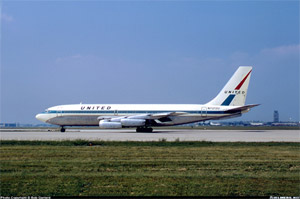
Photo copyright Bob Garrard - used with permission
On July 12, 1963, United flight 746, a Boeing 720 encountered severe turbulence while climbing through 37,500 feet near O'Neill, Nebraska, the aircraft stalled, entering a steep dive with a recovery at 12,000 feet. Flight 746 was climbing into a condition often referred to as "coffin's corner". As an airplane climbs into thinner air the stalling speed increases, at the same time the maximum allowable indicated airspeed decreases for a specific Mach number. As a result, the margin between the two limiting speeds progressively decreases with increasing altitude. Upon encountering turbulence, the airplane's speed dropped to the point where it entered a stall. The airplane oscillated several times between Mach buffet and stall before entering a steep dive losing 15,000 feet in approximately 20 seconds before recovery from the dive began to take effect. The occurrence of this incident just six months following the loss of Northwest flight 705 indicated that pitch upsets were not isolated.
On November 9, 1963, an Eastern Airlines DC-8 (N8603) departed Houston, Texas. While climbing through 19,000 feet, experienced an upset resulting in a dive. Airspeed reportedly dropped to zero momentarily, prompting the crew to push the nose down. The aircraft entered a steep dive and the flight crew employed reverse thrust recovering from the dive at 5,000 feet. Note that DC-8's were approved to use reverse thrust in flight.
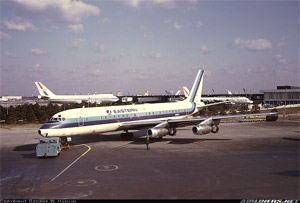
Photo copyright George W. Hamlin - used with permission
On November 29, 1963, a Trans Canada Airlines DC-8 crashed after take off from Montreal. The aircraft had climbed to some where between 5,000 and 7,000 feet before pitching downward. The investigation determined that the horizontal stabilizer was trimmed to 1.6 degrees aircraft nose down (AND). It was concluded that an un-programmed extension of the pitch trim compensator was the most probable cause for the pilot having applied full AND. Subsequent flight testing of a similar airplane showed an adverse effect on pitch stability with as little as 0.5 degrees AND and up elevator. The following quote from the report provides a perspective on the difficulty the flight crew would have experienced; "It is unlikely that the flight crew were aware of the serious stability and control problems that we now know can result from the combination of extended PTC (Pitch Trim Compensator) and AND trim, even if they had been aware that the PTC had been extended. The aircraft would then be in a condition where a slight displacement from its trim point would lead to divergent oscillations. In other words, a minor change of attitude, easily caused by the existing turbulence, would build up into large displacements. The inadequate control available to the pilot and the lack of an external horizon reference would likely result in the aircraft eventually assuming a dive attitude." View the Report of Commission of Inquiry.
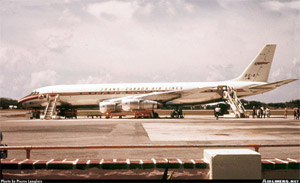
Photo copyright Pierre Langlois - used with permission
On February 25, 1964, an Eastern Airlines DC-8 (N8607) crashed into Lake Pontchartrain following take off at night from New Orleans, Louisiana and climbed to no more than 7,000 feet. Instrument meteorological conditions prevailed with moderate to severe turbulence in clouds below 6,000 feet. Examination of the wreckage indicated that the thrust reversers were providing reverse thrust at time of impact and the horizontal stabilizer was in the full AND position. The PTC was inoperative. The CAB report determined the probable cause of the accident to be "degradation of aircraft stability characteristics in turbulence, because of abnormal longitudinal trim positions." View the CAB accident report.
NTSB Study of Turbulence Related Accidents
In 1971, the National Transportation Safety Board (NTSB) released a report entitled, NTSB Lessons to be Learned from Turbulence Accidents 1971. The study deals with 97 turbulence-involved U. S. air carrier accidents occurring from 1964-1969. Based on the detailed investigation of those accidents, there is discussed lessons to be learned primarily from the point of view of the meteorologist, the air carrier and the pilot.
Technical Related Lessons
The areas in, and around, thunderstorms can contain severe turbulence, including strong updrafts and downdrafts. While flight in close proximity to thunderstorms is not recommended, if these phenomena are inadvertently encountered, flying techniques should involve maintaining moderate aircraft attitude and avoiding rapid pitch control inputs intended to preserve altitude or airspeed. (Threat Category: Incorrect Piloting Technique, and Inflight Upsets)
- While attempting to gain altitude and fly over the thunderstorm, the accident flight encountered a sudden updraft during the climb out of Miami, which led to the circumstances of the flight path upset. The investigators believed that in order to avoid what the pilot perceived as an impending stall, he applied full nose down elevator, accompanied by full nose down stabilizer trim. A number of flight path studies were conducted during the course of the investigation, in order to examine the consequences of various flight control strategies and techniques. The investigators concluded that if the flight crew had attempted to maintain attitude (roll and pitch attitudes near level flight), and not concentrated on maintaining either the rapidly changing airspeed or altitude, required control inputs would have been much less extreme, and the airplane would have successfully transited the updraft.
Flight in or near thunderstorms should be avoided, as thunderstorms can pose a very serious hazard to safety of flight, and involve severe rain and hail, icing, turbulence that includes extreme updrafts and downdrafts, and lightning. Although large transport airplane safety margins relative to these threats are robust, the most severe thunderstorms can exceed the capability of any airplane. (Threat Category: Inclement Weather/Icing)
- The investigators concluded that the thunderstorms on the day of the accident were not extraordinary and were typical of thunderstorms which routinely occur in the Miami area. It was a strategy at the time, for both aircrews and air traffic control to avoid flying in or near thunderstorms. Though attempting to maintain visual separation from the storm, the flight encountered a severe updraft which led to the pitch upset. Then as now, proper flight track planning, expeditious use of radar, and air traffic control vectors away from storms is a primary means of avoiding encounters with adverse weather conditions.
Common Theme Related Lessons
Trim systems are not primary flight control systems, and as such, should not be used as a means to effect flight path changes, or to augment elevator inputs. (Common Theme: Human Error)
- At the time of this accident, it was a common practice for pilots of transport airplanes like the 707 and DC-8 to use longitudinal trim in concert with the pitch controls for certain inflight actions. Control forces were sufficiently high that flight crews developed techniques for takeoff rotation, and other actions that required prolonged force application, that used the pitch trim almost concurrently with elevator, in order to reduce the required elevator forces. This was not a practice that was part of air carrier training and was not a practice recommended by the manufacturers. In this accident, investigators determined that the horizontal stabilizer was in the full airplane nose down position at the time of inflight breakup. Investigators concluded that in response to what the pilot perceived as an impending stall, he applied full nose down elevator, and almost simultaneous nose down trim. Trim was maintained until the electrical limit was reached. This resulted in an immediate, and aggressive airplane pitch down. As the airplane accelerated in the resulting dive, dive recovery controls were applied - nose up elevator, and airplane nose up trim. However, due to the air loads associated with the dive, the horizontal stabilizer trim motor stalled, and the stabilizer did not move in the nose up direction. Elevator effectiveness may also have been reduced by the presence of shock waves on the elevator and was not able to overcome the sustained nose down forces resulting from the full nose down trim position, and the dive became unrecoverable.
Horizontal stabilizer trim authority should be consistent with trim requirements, i.e., nulling of control forces, within a normal, expected operational envelope, based on the phase of flight (takeoff, climb, cruise, descent, and landing). Trim limits should provide sufficient pitch control margins that a capability to recover from an inadvertent pitch upset is available. (Common Theme: Unintended Effects)
- On all transport airplanes, the horizontal stabilizer is intended to balance the lift and pitching forces generated by the wing. As lift varies, the stabilizer is mechanized to rotate in order to vary the balancing forces it produces. Lift can vary, for example, as a result of changes to airplane configuration (flap/slat deflections), airplane weight (fuel burn), and changes in airplane center of gravity (fuel burn, passenger movement). It was determined by the investigation that the 707/720 model family had excess trim available in the airplane nose down direction. That is, more stabilizer movement was available than was necessary to trim the airplane within its expected normal operational flight envelope. As a result, an airworthiness directive was issued by the FAA to reduce the amount of trim available in the airplane nose down direction, thereby mitigating the effect of a mis-trimmed stabilizer.
